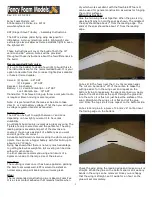
13
are not under pressure; you have to be careful not to over handle them
causing a stall or negative turn.
The trimmers must first be rolled-up before landing, and let the wing
fly at full speed and before reaching the ground you will have to pull
symmetrically on both the D-risers.
This braking method is not as effective as using the brake lines so you
will land at a higher speed.
4.5 KNOTS IN FLIGHT
The best way to avoid these knots and tangles is to inspect the lines
before you inflate the wing for take-off. If you notice a knot before
takeoff, immediately stop running and do not takeoff.
If you have taken-off with a knot you will have to correct the drift by
leaning on the opposite side of the knot and apply the brake line on that
side too. You can gently try to pull on the brake line to see if the knot
becomes unfastened or try to identify the line with the knot in it. Try to
pull the identified line to see if the knot undoes. Be very careful when
trying to remove a knot. When there are knots in the lines or when they
are tangled, do not pull too hard on the brake lines because there is an
increased risk of the wing to stalling or negative turn being initiated.
Before trying to remove a knot, make sure there are no pilots flying
nearby and never try these manoeuvres near the mountainside. If the
knot is too tight and you cannot remove it, carefully and safely fly to the
nearest landing place.
5. LOSING HEIGHT
The knowledge of the different descent techniques is an important
resource to use in certain situations. The most adequate descent method
will depend on the particular situation.
The following indications should be viewed as purely informative, solely
relevant to normal flying settings, and can not to be considered nor
viewed as a paragliding teaching manual. Only professional paragliding
schools can teach and prepare pilots to do all these maneuvers.
5.1 EARS
Big ears is a moderate descent technique, achieving about –3 or –4 m/s
and a reduction in ground speed of between 3 and 5 km/h. Effective
piloting then becomes limited.
To apply ears select the outermost A-line from each stabilizer as high
up as possible and pull them outward and downward in a smooth and
symmetrical motion. The wingtips will then fold inwards.
Releasing the lines will see the wingtips re-inflate automatically. If they
do not re-inflate, gently pull on one of the brake lines and then on the
opposite side. We recommend that you re-inflate asymmetrically, this
will reduce the risk of altering the angle of incidence which should be
avoided, more so if you are flying near the ground or flying in turbulence.
5.2 B-LINE STALL
When you carry out this manoeuvre, the wing stops flying, it loses all
horizontal speed and you are not in control of the paraglider. The air
circulation over the profile is interrupted and the wing enters into a
situation similar to parachuting.
5.3 SPIRAL DIVE
This is a more effective way for rapidly losing height. You have to know
that, the wing can gain a lot of speed and the increase in G’s will be
substantial.
Summary of Contents for Kougar-2
Page 1: ...USER S MANUAL KOUGAR 2...
Page 18: ...18 11 3 RISERS PLAN...
Page 19: ...19 11 4 SUSPENSION PLAN...
Page 22: ...KOUGAR 2 20 KOUGAR 2 23 22 11 9 CERTIFICATION SPECIMEN TEST...
Page 23: ...KOUGAR 2 25 KOUGAR 2 28 23...










































